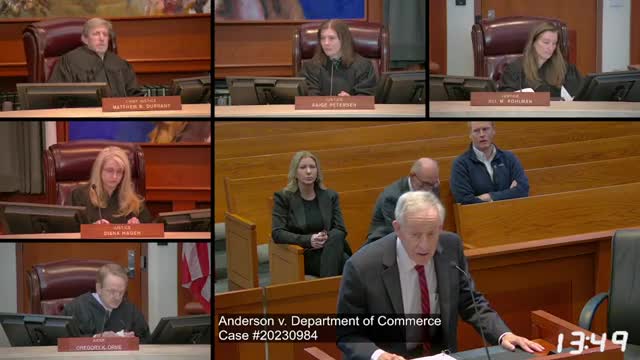Utah Nursing Board clarifies scope of practice in medical procedures debate
November 04, 2024 | Utah Supreme Court, Utah Judicial Branch, Utah
This article was created by AI summarizing key points discussed. AI makes mistakes, so for full details and context, please refer to the video of the full meeting. Please report any errors so we can fix them. Report an error »

In a pivotal session at the Utah Supreme Court, the case of Anderson v. Department of Commerce unfolded, drawing attention to the nuances of nursing practice regulations. As the courtroom buzzed with anticipation, the focus shifted to the core issues surrounding the definition of "scope of practice" within the Nurse Practices Act.
The attorney representing Miss Anderson emphasized that the case is not about the legitimacy of body contouring procedures or Miss Anderson's qualifications. Instead, it centers on the interpretation of key terms—diagnosis, treatment, and correction—within the legal framework governing nursing practices. The Utah Board of Nursing had previously affirmed that Miss Anderson's actions were within safe and acceptable standards, a decision that the Department of Commerce later contested.
The attorney argued that the legislature intentionally crafted broad and inclusive language in the Nurse Practices Act, allowing for a dynamic interpretation of nursing practices. This flexibility is crucial as medical practices evolve over time. The discussion highlighted that the legislature's choice of verbs—diagnose, treat, and correct—rather than a fixed list of procedures, underscores a progressive approach to healthcare.
Moreover, the attorney pointed out a critical inconsistency in how the Department of Commerce interprets the term "correction" in the Nurse Practices Act compared to similar definitions in the Medical and Osteopathic Practice Acts. This distinction could have significant implications for how nursing practices are regulated and understood in Utah.
As the arguments unfolded, it became clear that the outcome of this case could reshape the landscape of nursing practice in the state, potentially influencing how healthcare professionals navigate their roles in an ever-evolving medical field. The court's decision will not only impact Miss Anderson but may also set a precedent for future interpretations of nursing regulations in Utah.
The attorney representing Miss Anderson emphasized that the case is not about the legitimacy of body contouring procedures or Miss Anderson's qualifications. Instead, it centers on the interpretation of key terms—diagnosis, treatment, and correction—within the legal framework governing nursing practices. The Utah Board of Nursing had previously affirmed that Miss Anderson's actions were within safe and acceptable standards, a decision that the Department of Commerce later contested.
The attorney argued that the legislature intentionally crafted broad and inclusive language in the Nurse Practices Act, allowing for a dynamic interpretation of nursing practices. This flexibility is crucial as medical practices evolve over time. The discussion highlighted that the legislature's choice of verbs—diagnose, treat, and correct—rather than a fixed list of procedures, underscores a progressive approach to healthcare.
Moreover, the attorney pointed out a critical inconsistency in how the Department of Commerce interprets the term "correction" in the Nurse Practices Act compared to similar definitions in the Medical and Osteopathic Practice Acts. This distinction could have significant implications for how nursing practices are regulated and understood in Utah.
As the arguments unfolded, it became clear that the outcome of this case could reshape the landscape of nursing practice in the state, potentially influencing how healthcare professionals navigate their roles in an ever-evolving medical field. The court's decision will not only impact Miss Anderson but may also set a precedent for future interpretations of nursing regulations in Utah.
View full meeting
This article is based on a recent meeting—watch the full video and explore the complete transcript for deeper insights into the discussion.
View full meeting

